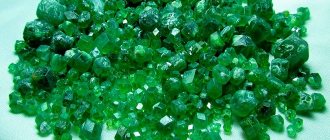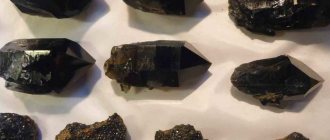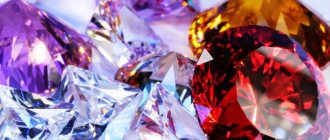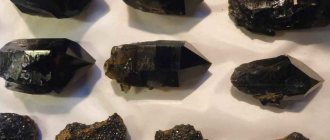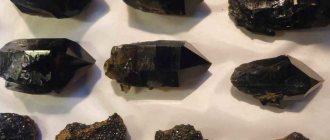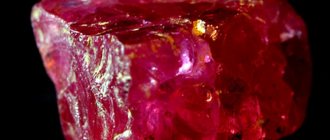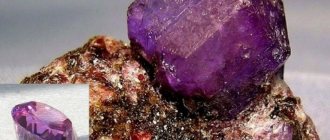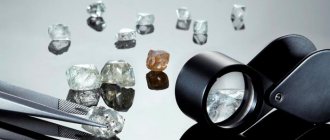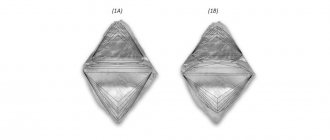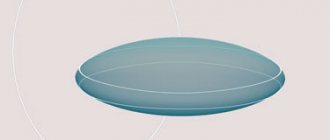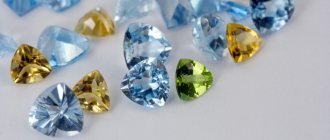Yakhont is a mysterious and multifaceted stone; this is what some gems were called in the old days and is still called by people. In an attempt to unravel the mystery of the gem, let's look to the past.
At all times, a large number of legends, tales and fables hovered around precious stones, which left a trail of old stories about the Yakhont stone. Nowadays, this is more a literary than an everyday name for stone jewelry, but not everyone is ready to forget this attractive word.
Many-faced stone: what are yachts
The word Yakhont was used to describe shiny stones with a distinct color. It is believed that this name comes from the Persian word "Yakut". And the latter, according to historians, comes from the Greek term “yakinthos” - that is, “hyacinth” - bright, shining and brilliant.
Today, few people will be surprised by jewelry with stones. It was a different matter in the old days: there were few open deposits, gems were mined without the help of complex mechanisms, expensive stones were not only an attribute of luxury, but were simply rare for ordinary people. So the rare stone was a wonder of jewelry for the people.
The value of some crystals was so high that especially large specimens were given proper names, and the attributes of rulers of peoples and countries were decorated with them. For example, Monomakh’s hat is decorated with yakhonts (there are blue, yellow, and red gems set in gold). The Great Imperial Crown of the Russian Empire has a red stone on top. The azure yacht crowns the crown of the Austrian Empire. Scroll through the photos of crowns:
Great Crown of the Russian Empire
Monomakh's hat, photo: interesnyefakty.org
Crown of Charlemagne
Crown of the Austrian Empire, photo: Dennis Jarvis, flickr.com
Crown of the Bavarian kings, photo: foter.com
What minerals were called yakhonts in the old days
Until the 19th century, all minerals of the corundum family (and not only) were called yakhont or lal, distinguishing subspecies according to the colors and shades of the mineral.
A detailed description of what color yachts are can be found in the translated texts of the greatest Armenian historian of the 17th century, Arakel Davrizhetsi:
- The ruby gemstone was called red and scarlet yacht, as well as padparadscha, spinel, garnet (7 half-tones of the stone were distinguished: the color of vinegar, wine must, purple, garnet, balkha, as well as sedimentary and lilac shades);
- Tourmalines of pink, red and crimson shades were also called red;
- And what kind of stone was called “azure yakhont” in the old days - sapphire. In Rus', the blue gem was called azure, thanks to its smooth and shiny blue surface, similar to the azure of a clear sky on a sunny day. Such a stone was divided into 5 subspecies according to color, comparing them with olives, the sea, clear daytime skies, evening and night skies;
- Cherry yakhont is an amethyst (although it does not belong to corundum, it was called yakhont);
- Hyacinth was called yellow (there were 4 types of tone - straw, wax, citrus and crystal). In ancient times, these gems were valued lower than their counterparts; they were figuratively said to be “still immature.”
However, there was no consensus throughout the world about whether specific minerals belonged to corundum. In the process of wandering through different languages and dialects, the word acquired various additions. It was the confusion that led scientists to decide to disown the inaccurate term.
Gems in Rus': names and magical properties
What names did precious stones have in Rus'? How did the Slavs choose them, for what magical purposes did they use them, and what magical properties did they endow them with?
Precious stones have always been highly valued everywhere. True, different gems were popular in different countries: in some places garnet was ranked higher than diamond, and in others even coral. And the creation of jewelry is one of the oldest human crafts. In Rus', they also loved precious stones, although they were very expensive, and only royal and princely families could afford them. Gems were used to decorate the robes of monarchs and princes, the vestments of clergy, and even icons. The latter skill has turned into a whole jewelry art, similar to mosaic. Gems were purchased, as a rule, from Byzantium or Arab countries. But, of course, gems came to Rus' from both India and Europe. As a rule, they purchased already cut stones, so the profession of a cutter was rare in Rus', until the 18th century, when their own gems were discovered in the Urals.
Our ancestors knew about 60 precious, semi-precious and ornamental stones. True, they all had completely different names back then, such that now we wouldn’t even guess what kind of gem we were talking about. For example, diamond was called adamant, turquoise - turkiz, amethyst - dumpling, and smoky quartz - in general, Siberian ground squirrel. As now, people also loved to attribute healing or magical properties to stones; just like now, then people also chose stones according to certain rules. Today we are guided more by the horoscope, but our ancestors selected gems for themselves by name.
Maybe in this regard they were smarter than us. After all, a precious stone doesn’t care what distant planet or star a person was born under the influence of. Our ancestors believed that a person’s name, pronounced several times a day, has much greater meaning. That it, like a magic word, makes the stone help or harm a person. The timbre, purity and pitch of the voice, as well as certain combinations of sounds that make up the name, create special sound vibrations to which the stone can “respond” and manifest its functions. Of course, if you believe this, then you should take into account the intonation with which your name is pronounced. And therefore, it is not advisable to wear stones when going to a place with a tense situation.
What other beliefs were associated with precious stones among the Slavs, and which one was valued more than others?
Precious Helpers
Our ancestors knew diamond It came to Russia from India at the beginning of the 16th century, and was not then as valuable as it is now. At the same time, cut diamonds (diamonds) appeared only in the second half of that century - they were purchased in Europe, where real cutting of stones was invented. Adamants adorned royal robes, crowns and scepters. They gained particular popularity among Russian courtiers during the reign of Ivan the Terrible. But besides this, diamonds were used as... medicine. They were crushed into small crumbs and “dissolved” in water. This solution was considered a powerful remedy against the “royal” disease - hemophilia. It was also prescribed for all illnesses, the main thing was that the patient could pay for it.
Aquamarine , in ancient times called augustite, was quite common in Russia. It was believed that jewelry with it protects a person from the evil eye and damage, as well as from people with bad intentions, for this stone endows its owner with fox-like cunning and insight. It was often presented as a gift, symbolizing fidelity and love. People also believed that if you look through aquamarine into the light, you can supposedly gain eagle vision.
Amethyst , also known as dumpling, symbolized purity of spirit. Therefore, they often decorated the vestments of clergy and church utensils: censers, candlesticks. Many ancient icons still have frames decorated with amethysts. People attributed to these stones the ability to reconcile warring people with each other and gain insight, that is, intuition. It was believed that he also helped a weak person gain strength of spirit, and a doubter find his path in life.
In ancient times in Russia, emerald It was a symbol of wisdom and tranquility, but that is not the only reason it was encrusted with royal regalia. It was believed that this stone protected against the evil eye and, what was even more important for the rulers, increased the intuition of the owner. True, for these magical properties to begin to act, the stone had to be worn for a long time without removing it. Another interesting property that was attributed to emerald: it could not stand malicious and deceitful people. If you communicate with them for a long time, you could negatively charge the stone, and it would then bring harm to its owner instead of benefit. Previously, there was a belief that emerald was able, in addition to everything, to treat heart disease and mental disorders, that it could even alleviate attacks of the “falling disease” - epilepsy.
The most common, accessible and beloved stone among the Russian people was amber , which our ancestors called alatyr or latyr. The Slavs had a special relationship with him; he was loved and revered as a symbol of health, happiness and vitality. In addition, amber is the only precious stone that the Slavs sold to the countries of Central Asia.
Amber is not a stone as such - it is a fossil resin of coniferous trees, formed in prehistoric times. In Rus', amber has been known since ancient times; jewelry, talismans and amulets, as well as buttons, pendants, and so on were made from it. It came to our ancestors from the shores of the Dnieper and the Baltic Sea - where amber is still being mined in large quantities. The craftsmen from Novgorod were considered the most skilled amber makers - they not only produced various products of unprecedented beauty, but also learned how to make varnishes from amber.
Alatyr was widespread among common people.
It was believed that it carries the vital energy of the sun, and therefore is able to help a person cope with difficulties and any illness. And so amber, like no other stone, has the right to claim healing properties. It is still used in medicine to make instruments needed for blood transfusions. The fact is that amber contains substances that prevent blood from clotting.
Officially: in explanatory dictionaries of the Russian language
Explanatory dictionaries of the Russian language describe in detail what “yakhonty” means:
- Dahl's large dictionary of the living Great Russian language (compiled in the middle of the 19th century) reads - “lal, ruby. Yakhont is worm-shaped (crimson-blue), red, actually a ruby. Yakhont is blue, blue is sapphire. The following are not yachts at all: cherry - amethyst; yellow - hyacinth." That is, according to Vladimir Ivanovich Dahl, an expert on Russian literature, cherry and yellow varieties of gems are called so figuratively, for example, as an analogy one can recall the “tiger eye” stone, which has nothing to do with the huge cats themselves, except for external similarity.
- The dictionary compiled by the Soviet linguist Sergei Ivanovich Ozhegov (first edition in 1949) mentions “the name of ruby and sapphire in the old days.” The definition is given briefly, without details, and an example of the use of the word is given in a figurative sense: “The eyes burn like yachts.” That is, there is a lack of information in the mid-20th century about the use of the term in its direct meaning.
We see the same in the dictionary edited by D.N. Ushakov, 1935 edition - “Interpretation of ruby and sapphire in antiquity.” “The Fable of the Fox and the Grapes” by I. A. Krylov is also mentioned there. “...The hungry godfather Fox climbed into the garden; The bunches of grapes in it were red. The gossip's eyes and teeth flared up; And the brushes are juicy, like yachts, burning...”
A little history
Precious minerals appeared, according to some documents, more than three thousand years ago. Even then, numerous varieties of these precious stones were discovered. The name of the most expensive and famous is diamond . Why is he the best? Because it is the hardest naturally occurring mineral on Earth. It cannot be destroyed by practically anything, except under the influence of enormous temperatures (about eight hundred degrees). Diamonds are mined mostly in African countries.
In ancient times, people appreciated the beauty of natural gems. At first they were used as amulets, worshiped, and sacrificed to idols. And only later they began to use it as decoration.
“Yakhontovy”, what is it?
The expressions “you are my yacht,” “yakhon eyes” have been preserved to this day.
The phrases deeply and thoughtfully emphasize that they say this to people who are dearly loved, dear to the heart on the one hand, and on the other, unattainable, not belonging in soul to the speaker. As a striking example, I remember Baba Yaga from the cartoon “The Adventures of Little Brownie Kuzi”, who exclaimed “You are my Yakhontovy”, according to the plot she understands that she will not be able to keep Kuzma in her mansion, but she will try to the last.
And they make a compliment about the eyes, uttering the words “yachon eyes,” pointing to the beauty and vital sparkle of the eyes they like, comparing them with the beauty and shine of expensive jewelry.
Agate
Agate is one of the most beautiful chalcedony. Rich color palette: green, white, orange, red, brown, black, elegantly striped, with subtle color transitions and inclusions...
Sometimes agate is formed in layers, which, depending on conditions and additions, turn out to be different colors. The most beautiful is considered white, layered and shimmering. Warm colors: yellow, brown, orange are given to agates by iron, and if the agate is green, it means the mineral contains chlorides. Sometimes the pattern of green agate resembles moss, and sometimes nature creates real pictures: green forests and dark mountains. Manganese inclusions create a pattern reminiscent of wood; they are called dendritic agates.
Agate is a stone of peace and tranquility, kindness and fidelity. It has long been believed that it protects a person in risky endeavors. Astrologers are sure that this stone has a positive effect on representatives of all signs. It is not for nothing that the name itself is believed to come from the Greek word “agates” - happy! Buy jewelry with agates, believe in yourself and be happy!
In prose and poetry
The word “yakhont” in books of the 19th-20th centuries was used to glorify images similar to a gem and to describe precious stones and jewelry.
The stone, as a true treasure, was mentioned in the writings of poets A. S. Pushkin and S. A. Yesenin, writers I. A. Krylov, A. N. Tolstoy and others. Here are a few quotes using the title in its literal sense:
- “A Guest from Gosha”, Davydov Zinovy. “...The knight rode, looking at the Master, counting the bags on his and his saddle, feeling the stones sewn into the cuffs, in the underfur and in the trim - Venetian yachts, Persian turquoise, large pearls...”
- “The Death of Ivan the Terrible”, A. N. Tolstoy “...Give me that harness with turquoise, with pearls, and with it that saddle cloth that is fattened with yahonts!” ..."
- “I asked the money changers today...”, S. A. Yesenin “... And the money changer answered me briefly: they don’t talk about love in words, they sigh about love only furtively, and their eyes, like yachts, burn...” The eyes, apparently, were compared with a blue gem called the azure yakhont.
A brief dictionary of stone names
Agate- There are three interpretations of this term. In mineralogy, agate is a banded variety of chalcedony. In stone processing, this name is used more widely: here agates include everything that in mineralogy is called “chalcedony.” From here came the “agate mortars” (made from chalcedony), moss, cloud, tubular and other agates that did not have banding. Finally, in the commercial and household sphere, agate is called black chalcedony (from A.S. Pushkin: “No, her eyes are not agate...”). In the book, the term “agate” is usually used in its first interpretation.
Aquamarine
- a blue or greenish-blue variety of beryl. Class II cutting stone.
Alexandrite
- a noble variety of chrysoberyl of a thick yellowish-green color, changing its color to crimson-red under artificial light. A rare cutting stone of class I, its deposits are rare. Nowadays, synthetic corundum is used as jewelry “alexandrite,” which is also capable of changing its color, but usually from light greenish-violet to pale red.
Diamond
- native carbon, the hardest natural formation. Class I cutting stone. As a result of cutting, transparent varieties acquire a strong shine, a characteristic “game” and are called diamonds. Synthetic diamonds are not widely used in jewelry.
Almandine
- ferrous-aluminum garnet of red or lilac-red color.
Amazonite
- ordinary potassium feldspar (microcline) of an unusual color for this mineral: green or bluish-green. Often with intergrowths (perthites) of white albite. A relatively rare jewelry and semi-precious stone. The only stable source of excellent quality amazonite in the country (and now, perhaps, in the world) is the town of Ploskaya (Keyvy, Kola Peninsula).
Amethyst
- violet quartz. Cutting stone; the best varieties belong to class II. A special variety is amethyst brushes; on an industrial scale they are mined only on the Kola Peninsula and are classified as jewelry and semi-precious stones.
Belomorit
- see moonstone.
Beryl
- silicate of beryllium and aluminum. Many beryls, beautifully colored and transparent, are cut stones (green emerald, blue aquamarine, yellow heliodor, pink sparrow). Beryl itself has a yellowish-green color, and occasionally it is completely colorless.
Turquoise
- hydrous phosphate of copper and aluminum. The mineral is blue or greenish-blue in color (blue turquoise is valued higher). Easily interacts with fats, oils, alkalis, carbon dioxide, as a result of which the color of turquoise becomes green.
Jet
- a dense variety of black brown coal (boghead), previously widely used for the manufacture of small carved items, inexpensive jewelry, and amulets. In the old days it was called black amber.
Heliotrope
- opaque dark green chalcedony with numerous small spots of red.
Gem
- carved stone. If the image is convex, the gem is called cameo; if it is recessed (signets), it is called intaglio.
Hyacinth
- a noble variety of orange or red zircon. Hyacinth is not mined in our country.
Rhinestone
- colorless transparent quartz. Class III cutting stone.
Grenades
- a large group of silicates, which may contain various di- and trivalent metals. Many representatives of this group are used for cutting (stones of classes II-III). The most famous are: red - pyrope, almandine; green - grossular, demantoid; black - shorlomite.
Dichroite
- one of the names of cordierite, associated with its ability to change color in different directions.
Gems
- “an indefinite name given to a multitude of crystals and invented, as it were, only in order to spread confusion in mineralogy, for the heap of stones united in this article is a collection so diverse that it is not even clear how and why they were united together before they were known." This definition, made by Academician V.M. Severgin at the beginning of the last century, has not lost its relevance to this day. Academician A.E. Fersman repeatedly spoke out against the name “precious stones,” especially in the last years of his life. The value (cost) of a stone is too variable a sign to be used as the basis for any classification. In this book, the term “precious stones” is used mainly in quotations and in the presentation of old material.
It seems more modern to divide colored stones according to the method of processing and areas of their application into cutting, jewelry and semi-precious stones. Cutting stones, in addition, depending on rarity and cost, are divided into three classes. Examples of stones belonging to a particular group or class are in the text of the dictionary.
Jade
- a mineral from the pyroxene group, sodium and aluminum silicate. In terms of physical properties (very high viscosity, fairly common green color) and processing technology, it is similar to jade. That is why, obviously, Chinese stone cutters - great experts on these stones - unite them under the common name “yu”.
Pearl
- an organogenic formation that occurs in the mantle of some freshwater and marine bivalves. Consists of calcium carbonate with an admixture of other substances. There are pearls of regular spherical shape (sloping) and irregular (baroque). In addition to the usual white ones with a pearlescent sheen, there are pink and even black pearls. Equated to class I cutting stones.
Coil
- Russian name for serpentinite.
Emerald
- a noble variety of beryl. The stone does not have a particularly strong shine or play, but is valued above other beryls for its rich green color, due to the presence of chromium impurities in the emerald. Class I cutting stone.
Cabochon
- the simplest form of inserts in jewelry, which has no edges. An ordinary cabochon is a combination of a smooth curved surface (top) with a plane (bottom).
A double cabochon can be easily imagined by folding two ordinary cabochons with flat bases.
Cabochons are made either from opaque stones (jasper, bloodstone), or from translucent stones (jade, chrysoprase), or from cloudy and fractured areas of cutting stones (emerald, aquamarine).
Carbuncle
- the ancient name for red garnet (pyrope or almandine).
Carnelian (cornaline)
- an exact synonym for the name “carnelian”. Attempts to distinguish an independent variety of chalcedony called “carnelian” are unfounded.
Quartz
- crystalline silicon dioxide. One of the most common minerals in the earth's crust. It has many varieties, differing in color and used as raw materials for cutting. The main ones are: rock crystal (colorless, transparent), citrine (yellow), smoky quartz (better known in everyday life as “smoky topaz”), morion (black), amethyst (purple). Amethyst is a class II cutting stone, the rest of the quartz belongs to class III.
In addition, quartz is the main mineral of many rocks used in colored stones (quartzite, vein quartz, aventurine).
Coral
— calcareous “skeleton” of a marine polyp. It is painted in different colors, but only red or black corals are used for decoration.
Cordierite
- aluminosilicate of magnesium, iron and aluminum. Colorless varieties resemble rock crystal, while colored varieties change color from blue to green to yellow, depending on the direction in which they are viewed. Sometimes used in cutting (class III stone).
Corundum
— aluminum oxide (alumina). Due to its high hardness, ordinary corundum is used to make abrasives, but its transparent and well-colored varieties are class I cutting stones (ruby, sapphire and some others).
cat's eye
- a mineral formed when some asbestos is impregnated and partially replaced by opal. It has a green color and a silky tint inherited from asbestos. In the East, one of the varieties of chrysoberyl (cymophane) is called a cat's eye. This particular variety is mentioned in the book.
Flint
- chalcedony or agate, containing a large number of impurities and therefore completely opaque, “deaf”.
Bloodstone
- a noble dense variety of iron ore - hematite. Red in powder, reddish-gray in a piece, when polished, bloodstone acquires a black color and a strong metallic sheen. The spelling “krovovik” used in the “Geological Dictionary” (M., “Nedra”, 1973) is certainly erroneous.
Blood Jasper
- one of the names of heliotrope.
Kunzite
- a rare variety of spodumene, lithium and aluminum silicate. It has a purple or lilac color that easily fades when exposed to ultraviolet rays. Class II cutting stone.
Labrador
- black sodium-calcium feldspar, iridescent in blue tones. Once upon a time in Rus' it was at a high price and was called “tausin” (peacock) stone.
Lapis lazuli (lapis lazuli)
- aluminosilicate of complex composition. It has a blue or blue color of different shades. High-valued jewelry and semi-precious stone. In ancient times it was used, in particular, for the production of very durable artistic paint (ultramarine).
Lal
- the old name for red spinel.
Moon rock
- a noble variety of adularia, potassium feldspar. Translucent, opalescent and iridescent stone in blue tones. (Not to be confused with the “moonstone” of W. Collins - we are talking about diamond there.) Now this name has been assigned to another feldspar - iridescent olico-eye from Karelia, which A.E. Fersman originally called belomorite.
Magnetite
- mineral, complex iron oxide. Has magnetic properties. Fine iron ore. Dense varieties are suitable for making black inserts.
Malachite
- copper carbonate. A very common mineral formed in the oxidation zone of copper deposits in the form of loose masses, however, its dense varieties suitable for making handicrafts and jewelry are very rare. Currently, the well-known Ural deposits, which once supplied large quantities of high-quality malachite, have been depleted.
Morion
- black quartz.
Nephritis
- a relatively soft stone with enormous viscosity (temporary compressive strength reaches 7000 kg/cm2). It is a tangled fibrous aggregate of actinolite (a mineral from the group of amphibole, calcium, magnesium and iron silicate). Usually green in different shades, but white, gray and black varieties are known. Widely used (especially in Asian countries) for making crafts, jewelry, and amulets.
Obsidian
- natural volcanic glass. The predominant colors are black, brown or brownish-red. Armenian silver obsidian, in which in some positions relative to the observer’s eye the black color gives way to silvery-pearl, is a spectacular jewelry and semi-precious stone.
Odontolitis
- a cheap variety of turquoise, formed by replacing the skeletal bones of vertebrates, especially their teeth, with this mineral.
Onyx
- a type of agate with a parallel-banded, rectilinear arrangement of layers. They differ: onyx itself (Arab onyx) - with alternating white and black layers, sardonyx - white and brown, carnelian onyx - white and red.
Opal
- an amorphous, glass-like variety of silica. The composition of opal necessarily includes water, the content of which reaches 20% (usually 1-4%). It is capable of dehydration, but under natural conditions it usually degenerates into chalcedony. There are many varieties of opal. Noble opal is valued above others. If all translucent varieties of this mineral are opalescent, then noble opal also iridescent with all the colors of the rainbow.
Rhodonite (or orlets)
- manganese silicate of pink or grayish-pink color. Rhodonite, which has no equal in the world, has a juicy crimson color with a clear pattern formed by secretions of black manganese hydroxides, and is mined in the Urals, not far from Sverdlovsk. One of the famous jewelry and ornamental stones on which Russian stone-cutting art was created and developed.
Ruby
- a noble variety of red corundum. Synthetic ruby, now widely used in the jewelry industry, has all the chemical and physical properties of natural ruby.
Rubellite
- pink tourmaline.
Sapphire
- noble blue corundum.
Sardonyx
— onyx with alternating white and brown layers. In ancient times, it was a favorite material for making cameos. The Hermitage's most famous gem, the Gonzaga cameo, is carved from three-layer sardonyx.
Cornelian
(literary pronunciation requires stress only on the last syllable - carnelian) - chalcedony of red, orange or pink color. It is precisely in color, and only by this, that it differs from brown sarder and yellow ceragate.
Serpentinite
- a rock composed of the mineral serpentine (hydrous magnesium silicate). Cheap ornamental stone of medium hardness.
Hawkeye
- is similar in origin to a cat's eye, differing from it in its blue color: in this case, blue rhodusite - asbestos - is impregnated with opal. Deposits of the hawk's eye, a valuable jewelry and semi-precious stone, are located in Central Kazakhstan.
Tektites
- glass-like formations, apparently of cosmic origin. They are found in the youngest sediments or even on the surface of the earth. The color is green or black, the surface texture is uneven and lumpy. Found in Australia, Indonesia, USA and other places. The most famous green tektites from Czechoslovakia - moldavites - are used to make original inserts into jewelry.
Topaz
- aluminum silicate containing fluorine. Pink, blue, tea, wine, colorless. Widely known in trade and in everyday life, “smoky topaz” has nothing to do with topaz: it is smoky quartz. Either citrines or synthetic yttrium garnets are usually sold under the name “golden topazes”. Topaz itself is a Class II cutting stone.
Trichroite
- one of the names for cordierite.
Tourmalines
- a large group of minerals of a very complex chemical composition. Depending on the color they differ: pink - rubellite or elbaite, green - verdelite, blue - indigolite, brown - dravite, black (the most common) - schorl. There are also multi-colored (polychrome) varieties in which, for example, one end of the crystal is pink and the opposite end is green. Cutting stone of II-III classes.
cubic zirconia
- a new type of cutting raw material, synthesized at the Physical Institute of the USSR Academy of Sciences (FIAN - hence the name of the stone). The composition is zirconium oxide. It has high hardness, high gloss and a wide palette of colors, depending on the composition of the additives introduced into the charge. Now our industry produces jewelry with cubic zirconia in a soft lilac color.
Fluorite (fluorspar)
— variously colored (sometimes in one specimen) mineral, calcium fluoride. It is very soft and fragile, therefore it is used in stone cutting as an ornamental raw material and only occasionally for making jewelry.
Chalcedony
— cryptocrystalline quartz aggregates of various colors and compositions. There are plain and patterned chalcedony. The first include: gray - chalcedony itself, pink or red - carnelian, brown - sarder, green - chrysoprase, etc.; the second includes various agates, heliotrope and some other stones.
Chrysoberyl
- a complex oxide of beryllium and aluminum. It has two main varieties used in jewelry: the Ural variety - alexandrite and the Ceylon variety - tsimofan, or cat's eye.
Chrysolite
- a noble variety of the mineral olivine (iron-magnesium silicate). The stone is yellow-green in color, usually found in small (fractions of a centimeter) formations, but one of the seven historical stones of the USSR Diamond Fund - faceted chrysolite - weighs 192.6 carats.
Chrysoprase
- chalcedony, colored green or bluish-green in natural conditions by secondary nickel compounds.
Chrome diopside
- a noble variety of ordinary diopside (pyroxene, calcium and magnesium silicate). Thanks to the admixture of chromium, it has a green color (from yellowish to emerald green). Transparent varieties are cut. Rich deposits of this mineral were discovered relatively recently in South Yakutia.
Colored stones.
— In modern Russian scientific terminology, there is no established and generally accepted name that unites the entire complex of stones used for making jewelry, crafts and other similar products. The diversity in this matter is clearly evidenced by the titles of the works given in the list of recommended literature: after all, they are all devoted to the same stones. In this book, the term “colored stones” is used to refer to this complex of stones.
Zircon
- mineral, zirconium silicate. It has several noble varieties, the most famous of which is hyacinth.
Spinel
- complex oxide of magnesium and aluminum of red, lilac, green, black color. Red spinel is a class I cutting stone. The best varieties of it are indistinguishable from ruby in appearance.
Amber
- petrified resin of ancient pine trees. Equated to class III cutting stones. The world's largest deposits are in the Soviet Baltic states.
Yakhont
- the ancient name for precious stones of the corundum group.
Jasper
(accent on the first syllable - jasper) - a fine-grained rock consisting mainly of minerals of the silica group (quartz, chalcedony). Jaspers are usually colored by tiny intergrowths of other minerals in various colors. There are single-colored, ribbon, spotted, patterned, etc. In our country, which is rich in deposits of various jaspers, Orsky landscape jaspers are especially prominent. They, in the words of Academician A.E. Fersman, are the national treasure of Russia.
In the ancient texts of the Bible and Koran
The first mentions of the mineral can be seen in the Bible (Exodus 28:19; Exodus 39:12). The translation of the biblical texts says that the yakhont stone is a precious gem, the third of twelve attached to the chest leather vestment of the high priest.
Casket of the Polish princess Jadwiga Jagiellonka, photo: hermitagemuseum.org
Fragment, photo: hermitagemuseum.org
Photo: Nata-Ko, liveinternet.ru
There is also a mention by Arakel Davrizhetsi about Mount Salandir-Dagi in Ceylon, as if Adam descended on it after his expulsion from Eden, and after which the yahonts began to exist there. And as this Armenian scientist of the 17th century noted in his works, that besides this mountain, these gems cannot be found anywhere else.
In the Koran, the ancient concept is found once in the interpretation of ABU Adel in Sura 88 “The Covering One,” verse 13: “There are beds erected.” The explanation to the sura says the following: “The beds of paradise are made of gold, decorated with chrysolite, pearls and yakhont.”
Magical and healing properties
Amirdovlat Amasiatsi, (Armenian naturalist, scientist of the 15th century, personal physician of Sultan Mehmed the Conqueror) pointed out that there are 5 types of yakhont, pompously emphasizing that the nature of the mineral is dry and cold. Preferring the colors of the stone - garnet and red, the author attributed to them the healing properties of helping with a weak heart and palpitations. The doctor advised women who breastfeed their children to wear the gem to maintain lactation.
To improve your mood, it was recommended to take the crystal in your mouth.
He also pointed out the property of harmonizing the body and enlightening the soul with the help of the stone, saying that those who wear it will be attractive to others. But it is quite possible that we were talking about a blue gem, since from other sources it is known that ancient esotericists did not recommend wearing a red yakhont to choleric people, and people prone to passion, violence, and rowdyism. They claimed that lalas, scarlet rubies, contributed to increased mood swings. For this, the red mineral was called the stone of anger.
But about the cherry yakhont, amethyst, they said that when taken into the mouth, a person’s thirst went away. Amethyst was credited with healing properties for many eye diseases.
Be careful if you come across information that supposedly “ground corundum is taken to treat male impotence, eye diseases and colds,” the result of such “treatment” can be disastrous. If, of course, you succeed, you can crush corundum, which is only harder than diamond. Perhaps this is what they did in the Middle Ages.
Remember that as a therapy, the stone is used exclusively in folk medicine. First of all, you need to contact a medical facility and not self-medicate.
Magic properties
The magical properties of blue corundum are no less pronounced than their healing properties. The stone literally exudes witchcraft energy. It attracts people related to the mysterious and forbidden - magicians, sorcerers, clairvoyants, psychics.
Blue sapphire is capable of developing the gift of clairvoyance.
How the magic of sapphire manifests itself:
- the stone protects its owner from the evil eye, black magic, and energy attacks;
- enhances positive character traits, develops willpower;
- like rock crystal, it serves as a conductor between worlds - it helps to communicate with the souls of the dead, all sorts of otherworldly entities;
- the gem strengthens love bonds - protects against betrayal, minimizes the number of quarrels, dispels misunderstandings - therefore it is useful for women to wear sapphire.
Which color to choose:
- the blue mineral opens the “third eye” - helps make predictions;
- white restores the aura and also promotes spiritual development;
- pink - helps to open up to the world, free yourself from negative attitudes, hidden fear;
- black - adds calm, restores self-confidence, prevents you from falling into depression;
The star mineral has one of the rarest abilities - it can recognize the lies of others. Such an amulet will be useful for those who have to frequently come into contact with others - lawyers, politicians, businessmen.
Physical properties of minerals
The physical properties of the stone were described as follows: they suggested throwing it into molten gold, and noted that the gem did not burn or deteriorate, that is, they compared the melting point of the mineral with gold.
The size of a carat of yakhont was compared with 4 grains of wheat.
If we talk about modernity, blue or light blue yacht is a sapphire, and pink is a ruby. Both crystals are corundum, but differ in their chemical component: their base is aluminum oxide, the pink tint is caused by chromium, and the rich blue and violet are due to titanium and iron.
Corundums have a hardness of 9 out of 10 on the Mohs scale, which makes them extremely durable and not subject to mechanical damage.
Diamond
A diamond is a transparent artificially cut diamond. The word “diamond” comes from the Greek “indestructible.” And it is no coincidence, because the cubic allotropic form of carbon (this is the scientific definition of diamond) is the hardest mineral on the Mohs scale.
Diamonds are rightfully considered the best among precious stones. The French word brillant itself means “brilliant”, “sparkling” and expresses what diamonds are so valued for: none of the stones has such a deep radiance and such an indescribable play of light. Diamonds are graded using the 4 C system: cut, clarity, color and carat. The higher each characteristic, the closer the diamond is to perfection. Diamonds with 57 facets are called full-cut. They have ideal proportions to achieve maximum brilliance and maximum play of light inside the stone: there are 33 facets on the top of the diamond and 24 on the bottom. Purity is expressed as the absence of defects or foreign inclusions. A perfect diamond is called a pure diamond.
By color, diamonds are divided into traditional (colorless and all shades of yellow) and fancy (pink, blue, indigo and even green). The weight of diamonds is measured in carats (1 carat equals 0.2 grams). Diamonds pair perfectly with most gemstones and especially well with emeralds, sapphires and rubies.
